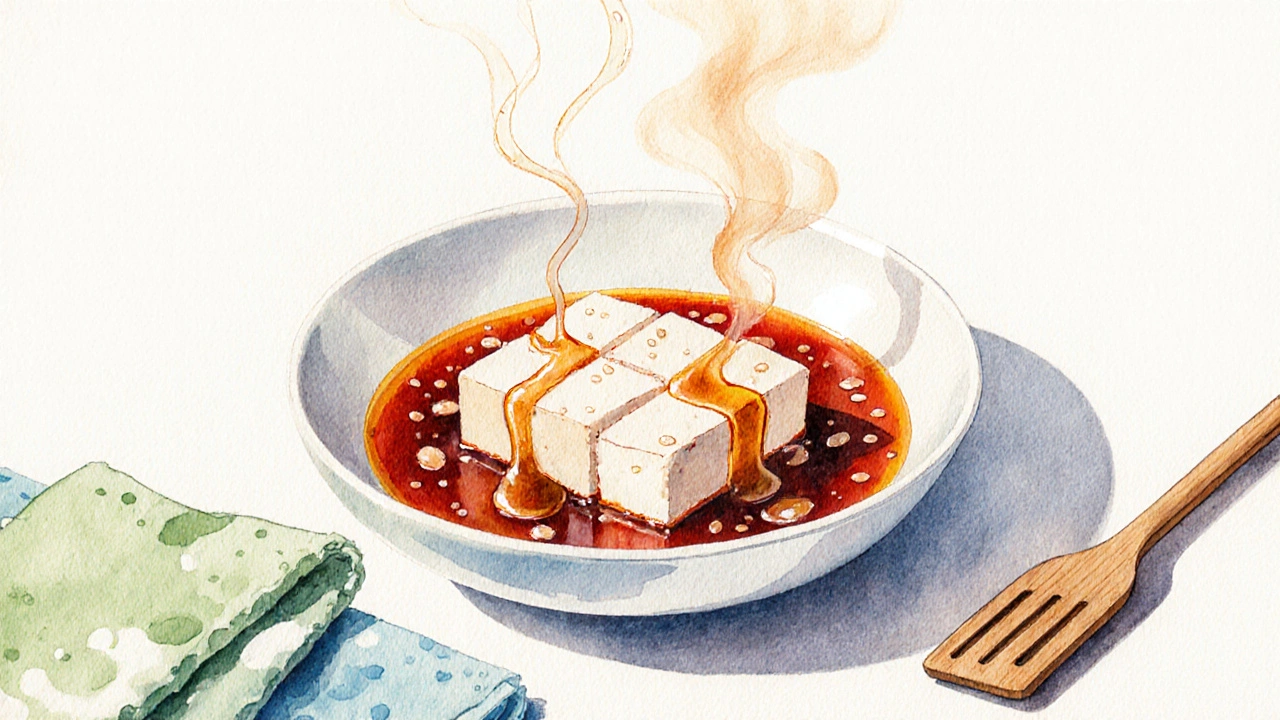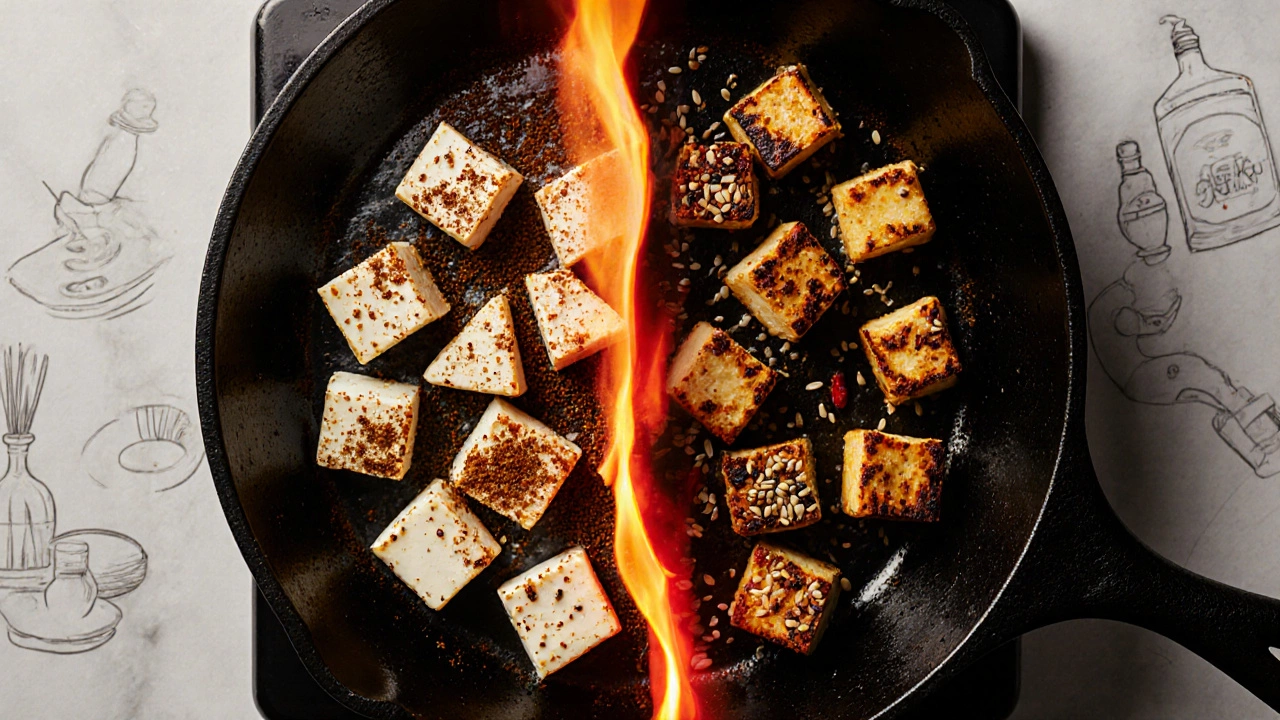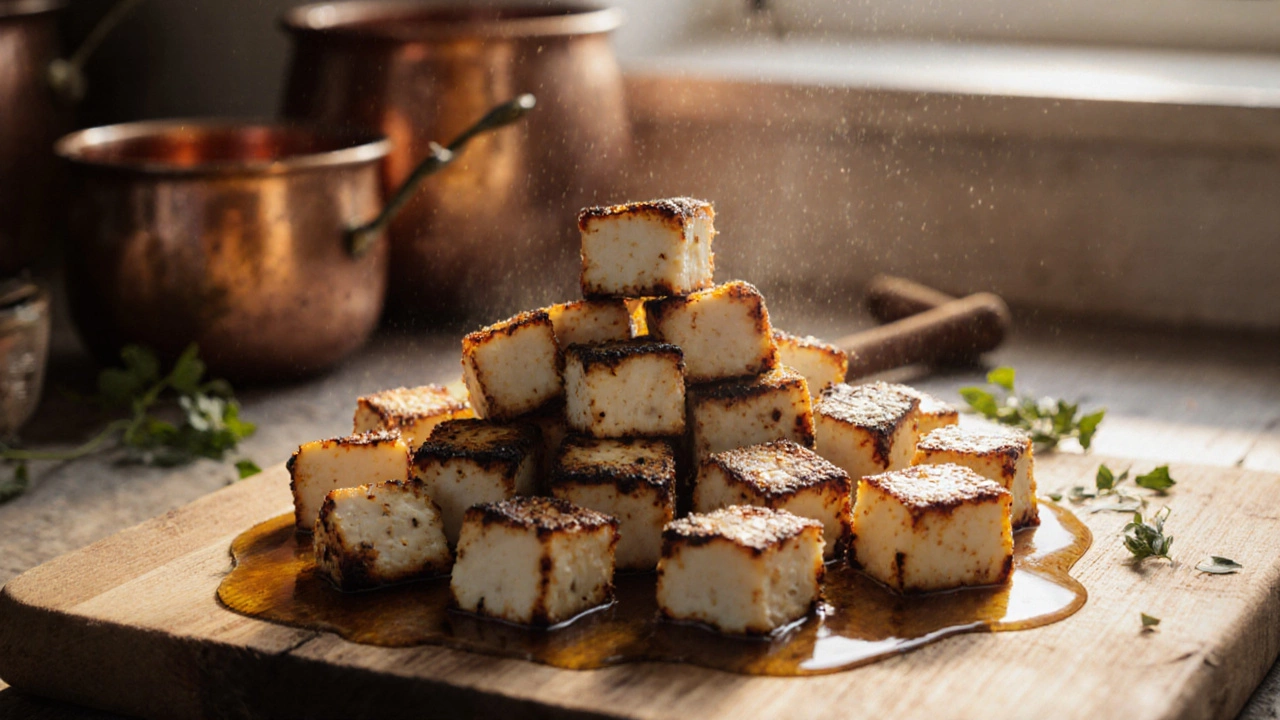Flavor Potential Calculator
Choose Your Protein
Select Cooking Method
Preparation Steps
Quick Takeaways
- Paneer delivers a buttery, milky richness that many people find instantly satisfying.
- Tofu starts out mild, but a good marinate or high‑heat cooking can unlock deep umami notes.
- Texture is a major driver of perceived flavor - paneer’s crumbly‑soft bite vs tofu’s silky‑smooth mouthfeel.
- Both proteins are versatile; choose based on the dish, cooking method, and personal flavor preference.
Understanding Paneer’s Flavor DNA
Paneer is a fresh cheese made by curdling heated milk with an acid or enzyme, then draining the whey. The process leaves behind Casein proteins, which trap fat globules and lactose. When you bite into paneer, those trapped fats melt, releasing a buttery, slightly sweet note that registers as “milky” on the palate.
Natural savory compounds such as Glutamate are present in small amounts because milk contains free amino acids. However, the real taste boost comes from the Maillard reaction when paneer meets high heat - think golden‑brown cubes in a tikka or a pan‑fried tikka masala. That crust adds caramelized, nutty tones that many describe as “rich” or “savory”.
Why Tofu Often Gets a Bad Rap for Taste
Tofu is a soy‑based curd made by coagulating soy milk and pressing the curds into blocks. Its primary protein source is soy, which contains Isoflavones. These phyto‑estrogens are mildly bitter, but the manufacturing process strips most of the flavorful lipids, leaving a product that feels almost neutral.
That neutrality is both a curse and a blessing. On its own, tofu’s taste profile is described as “bland” or “watery”. The lack of natural fat means fewer flavor‑carrying molecules, so the tongue hears mostly the subtle grainy texture and a faint nutty aftertaste. Without a seasoning step, many first‑time tasters think tofu is tasteless.
Texture: The Silent Flavor Amplifier
Texture influences how quickly flavor compounds are released. Paneer’s crumbly‑soft interior breaks apart easily, allowing saliva to dissolve the butterfat and deliver taste quickly. Tofu, especially silken varieties, holds together longer, slowing flavor release and making the experience feel milder.
Firm tofu, when pressed to remove excess water, develops a denser bite that can mimic paneer’s firmness. Yet, even a firm block still lacks the same melt‑in‑the‑mouth feel because soy protein forms tighter, less porous networks than casein.

Cooking Methods That Turn the Tables
Heat is the great equalizer. A simple grill or skillet sear creates a caramelized crust on both proteins, boosting their umami.
Paneer thrives on quick, high‑heat cooking - think paneer tikka skewers or a stir‑fry with bell peppers. The crust locks in juices, while the interior stays soft.
Tofu benefits from a two‑step approach: press, then marinate, then cook at high temperature. A soy‑ginger‑garlic glaze, followed by a quick sear, creates a crisp exterior that releases the glaze’s aromatics directly onto the palate. The result is a dish that can out‑shine plain paneer in flavor intensity, especially in Asian‑style preparations.
Nutritional Profile vs. Perceived Taste
Both paneer and tofu offer about 18‑20 g of protein per 100 g, but their fat content diverges. Paneer’s 15‑20 g of saturated fat carries flavor, while tofu’s 4‑5 g of polyunsaturated fat is more neutral.
For those tracking calories, tofu’s lower caloric density can be appealing, but the trade‑off is a need for stronger seasoning. Paneer’s richer mouthfeel often means you need less sauce to feel satisfied.
How to Make Tofu Taste Like a Star
- Press the tofu for 30‑45 minutes to expel excess water.
- Slice into 1‑inch cubes and marinate for at least 15 minutes. A mix of soy sauce, rice vinegar, ginger, garlic, and a dash of maple syrup works wonders.
- Heat a non‑stick pan with a splash of oil until it’s shimmering.
- Add tofu and let it sit undisturbed for 3‑4 minutes per side. The goal is a deep golden crust.
- Finish with a sprinkle of toasted sesame seeds or a drizzle of chili oil for an extra flavor punch.
These steps introduce Umami compounds from the soy sauce and caramelized sugars, turning bland tofu into a savory delight.

How to Boost Paneer’s Flavor Without Going Crazy
- Use fresh, whole‑milk Milk for your homemade paneer; higher fat content equals richer flavor.
- Add a pinch of salt and a touch of sugar to the curdling water; this balances the natural sweetness.
- After draining, let the paneer rest in the refrigerator for 2‑3 hours. A short “aging” period allows the protein matrix to tighten, improving texture.
- Before cooking, coat cubes in a light dusting of chickpea flour and spices (cumin, coriander, smoked paprika). The flour creates a crisp crust that locks in buttery juices.
- Finish with a squeeze of lemon or a drizzle of herb‑infused oil for a bright finish.
Verdict: Who Wins the Taste Test?
If you crave an instant buttery richness and want a protein that feels luxurious on its own, paneer takes the lead. Its natural fats and casein structure deliver flavor without much help.
If you’re open to a quick marinating step and love high‑heat searing, tofu can match-or even surpass-paneer’s taste intensity, especially in sauces that layer soy, ginger, and chili.
Bottom line: Neither protein is inherently “tastier”. The winner depends on preparation, seasoning, and the dish you’re aiming for. Keep both in your pantry and let the recipe guide your choice.
Frequently Asked Questions
Can I use store‑bought paneer for this comparison?
Yes, but fresh whole‑milk paneer will taste richer than low‑fat packaged versions. For a fair side‑by‑side taste test, choose the highest‑fat option available.
Is pressing tofu really necessary?
Pressing removes excess water, letting marinades cling better and creating a firmer texture that browns nicely. Skipping this step often leaves tofu soggy and flavor‑poor.
Which protein has more calcium?
Paneer typically contains about 200 mg of calcium per 100 g, while firm tofu (often set with calcium sulfate) can have 150‑300 mg. The exact amount depends on the coagulant used.
Can I freeze paneer or tofu without losing flavor?
Both freeze well, but tofu tolerates freezing better because the water crystals break the protein network, creating a spongier texture that soaks up sauces. Paneer can become crumbly; thaw gently and use in cooked dishes.
Is there a health reason to pick one over the other?
If you watch saturated fat, tofu is the lower‑fat choice. For calcium and vitamin D (if fortified), paneer often has the edge. Choose based on dietary goals and taste preference.
Flavor Comparison Table
| Attribute | Paneer | Tofu |
|---|---|---|
| Primary flavor notes | Buttery, milky, slightly sweet | Neutral, mild nutty |
| Typical texture | Creamy interior, firm exterior when cooked | Silky (soft) to dense (firm) depending on pressing |
| Common cooking methods | Grilling, frying, simmering in curry | Stir‑fry, bake, braise, deep‑fry after marinating |
| Protein (g/100 g) | ≈18 | ≈17 |
| Natural umami compounds | Low‑level glutamate, enhanced by Maillard | Isoflavones (mild bitterness), amplified by soy sauce |
Whether you pick paneer or tofu, the secret to great taste lies in the cooking method, seasoning, and respecting each protein’s natural strengths. Experiment, have fun, and let your taste buds decide the winner.
